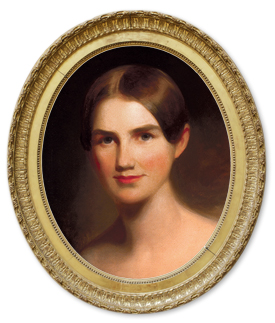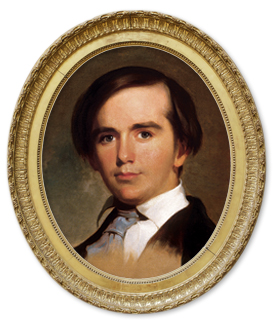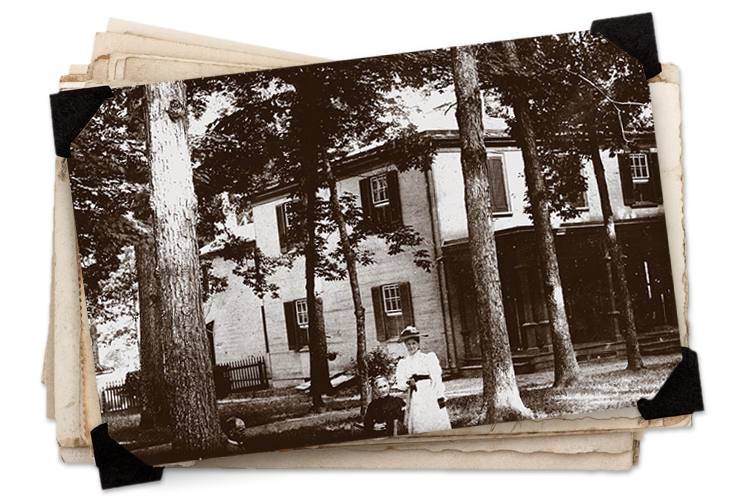House of Blair
[rev_slider BlairHouse]
Students at the Takoma Park/Silver Spring Campus amble past it, generally paying more attention to their cell phones than the architecture. Georgia Avenue traffic motors past it, coughing out carbon monoxide alongside it. Birds perch atop it, eyeing the old-growth trees and park visitors nearby. With time and vacancy, the old house at 900 Jesup Blair Drive receded into the landscape. But efforts by the Parks Department and Montgomery County may bring the Jesup Blair House back into use.
The ca. 1850 “Moorings,” also called the Jesup Blair House, was one of three summer residences built by Francis Preston Blair Sr.’s family. This stately home was built specifically to house his son, James, and James’ wife, Mary Blair. Francis Preston Blair (1791–1876) was a journalist, founding member of the Republican Party, and founder and editor of The Washington Globe.
Originally from Kentucky, Blair Sr. and wife, Violette (Eliza) set up residence (Blair House) on Lafayette Square, across from the White House (1837) with their four children: Montgomery, James, Frank, and Elizabeth. Their home served as an informal meeting place for President Jackson’s unofficial advisors, referred to as the Kitchen Cabinet. Later, President Lincoln crossed the street to consult with his neighbor, Blair. It remains in use today by the US president as a guest house for visiting heads of state.

Elizabeth Blair Lee was prominent in 19th century social circles. Portrait by Thomas Sully. Courtesy of Blair House, US Department of State.

James L. Blair was prominent in 19th century Washington politics. Portrait by Thomas Sully. Courtesy of Blair House, US Department of State.
In the mid-1850s family members built three summer residences on their Maryland property: “Silver Spring” (ca. 1842), Blair Sr. and Eliza’s home; “Falkland” (1854), built for the Montgomery Blair family; and “The Moorings” (ca. 1850), built by Blair and his daughter-in-law, Mary Serena Jesup Blair. This third home, known today as the Jesup Blair House, is the only surviving Blair home.
The once-grand house had 13 rooms, several chimneys, and a bathroom. When Mary and her children—Violet, Jesup, and Lucy—lived there, the house was a Greek Revival structure with modest Victorian trim and a front porch. When Mary’s daughter, Violet Blair Janin (1850–1932, married to Judge Albert C. Janin), inherited The Moorings in 1914, she was ensconced in Washington social circles and charitable organizations. She bequeathed the house and its 14-plus acres to the state of Maryland, stipulating that it remain in public use and be renamed the Jesup Blair House, in honor of her brother who predeceased her in 1902.

The Blair House as it appeared prior to the architectural changes made in 1935.
Its first use was as a public library. In 1934, the state commissioned architect Howard Cutler to convert it for that purpose. Cutler’s other public building designs included Montgomery Blair High School, Chevy Chase Elementary School, and Bethesda/Chevy Chase High School. He removed the home’s front porch and Victorian trim, following the Colonial Revival movement of the 1930s. His design work is what remains today—and what earned the house a nomination for placement on the National Register of Historic Places in 1975.
When the library closed in 1957, the house was repurposed for other community needs: as a draft board and community center, an apartment building for a park groundskeeper, the Chelsea School, and transitional housing for single parents. In 1985, it was designated and placed on the Montgomery County Master Plan for Historic Preservation. Inevitably, it was closed for repairs in 2008.
“The building is being stabilized, mold and lead paint abated, but the inside of the building still has to be restored and rehabilitated,… says Kuhns. Walls, floors, and ceilings need care and repair. An entirely new HVAC system along with electricity and plumbing need to be installed.”
The County Council has supported the project with ongoing funding of the structural work. Project managers estimate it will take two years to bring the building back to usable condition. The Parks Department’s goal is to return it to a lease-able condition and is working to form partnerships for use. Those may include Montgomery College, the Silver Spring Historical Society (housing for its archives), and a community room restored to an
1850 appearance.
—Diane Bosser
[rev_slider BlairPark]
Blair Park
In September 1934, Montgomery County officially opened Blair Park. The 14-acre swath envelops the historic Jesup Blair House and includes sports fields and an amphitheater. Local citizens, history lovers, and green-space enthusiasts, including the Silver Spring Historical Society and civic groups, treasure the park’s 250 trees. Among its 42 tree species are 100 historic forest trees, some more than 200 years old. The Department of Parks has planted more than 100 new trees and installed designated paths for patrons and students—which prevent soil compaction above tree roots.
Local devotion and the College’s need for more space clashed briefly in 2000, when the College floated a request to build on a small northeast section of the property. Objectors organized and blocked the proposal, which included removal of 43 trees from the park. MC instead purchased the old Giant Foods Heidi Bakery production and distribution facility on King Street to build The Morris and Gwendolyn Cafritz Foundation Arts Center Building and a 350-car parking garage.
For more information about the Jesup Blair House and the Blair family, visit the Takoma Park/Silver Spring Campus and neighboring Blair Park, or take a virtual tour of the family’s Washington, DC, home at blairhouse.org.
—Diane Bosser



Where are photos of the playground? My siblings and I stent time on them before going to the Library to get our books. About 1947 to when it closed..
I recall spending time here when it was some kind of preschool in the early ’50s. We loved recess on the grounds and the excitement of the trains going by. I recall lying on the floor for naps in a large room after graham crackers and milk. Because of the size of the grounds I’m fairly certain there was no other site comparable in Silver Spring and the train tracks were behind and along the east edge of the property.
About the time we went to the play ground, did you play on it? My sisters and I played and my brother spent the time sitting watching the trains go by.